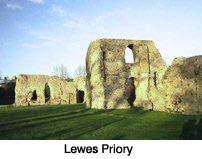Lewes Priory to be brought to life thanks to Heritage Lottery Fund grant
 One of the most important historical buildings in South East England, Grade I listed Lewes Priory, is to be transformed into a top visitor attraction thanks to a confirmed* Heritage Lottery Fund (HLF) grant of £545,500.
One of the most important historical buildings in South East England, Grade I listed Lewes Priory, is to be transformed into a top visitor attraction thanks to a confirmed* Heritage Lottery Fund (HLF) grant of £545,500.
 The two year project will include conservation of the remains of the Norman site, making them safe for visitors, as well as exciting improvements to access and interpretation of the Medieval Monastery which will bring the attraction alive for 21st century visitors. The inner fencing will be removed and firm pathways, benches and interpretive signs will be installed. There will also be an educational programme for schoolchildren, students, academics and the general public, and opportunities for greatly increased volunteer involvement. The work is expected to be completed during 2010.
The two year project will include conservation of the remains of the Norman site, making them safe for visitors, as well as exciting improvements to access and interpretation of the Medieval Monastery which will bring the attraction alive for 21st century visitors. The inner fencing will be removed and firm pathways, benches and interpretive signs will be installed. There will also be an educational programme for schoolchildren, students, academics and the general public, and opportunities for greatly increased volunteer involvement. The work is expected to be completed during 2010.
Stuart McLeod, Head of the Heritage Lottery Fund in the South East, said:
“This is one of the most important historical and archaeological sites in the south-east - on a par with Lewes Castle. However, with little interpretation for locals or visitors to understand the sites’ rich history, and it currently being fenced off as unsafe, this much needed award from HLF will provide a bright future for Lewes Priory for generations to come.”
The Scheduled Ancient Monument, also on EH’s ‘Heritage at Risk’ register, was founded as a Cluniac Monastery in approximately 1081 by Williame de Waranne and wife Gundrada. A rich Norman who fought at the Battle of Hastings in 1066 with William the Conquerer, de Warenne also founded Lewes Castle, which can be viewed from the Priory.
An instrumental medieval site, Lewes Priory was the parent monastery of the Cluniac monks in England, and played a critical part in the Battle of Lewes, where King Henry III based himself and eventually negotiated the Mise of Lewes with Simon de Montfort, an important step forward in the development of democracy in England. When the Dissolution of the Monasteries came in the 16th Century it was demolished under the orders of Thomas Cromwell, and much of its stonework was cannibalised and can be found in buildings in Lewes and for miles around.
Baroness Kay Andrews, Chair of English Heritage, explains the importance of saving the site for future generations:
“This is indeed wonderful news. Wonderful that such a significant part of our national history will now be made safe and brought back to life; wonderful for the whole Lewes community who will now be able to take pride and pleasure in a monument that means so much to the history of our town; and wonderful for everyone who will visit, enjoy, learn about and care for the Priory in years to come. We owe a major debt of thanks to the Priory Trust who have kept the faith and worked so hard to bring this achievement about.”
John Lawrence, Chairman of the Priory Trust, an organisation run entirely by volunteers who administer the site on behalf of Lewes Town Council, has been integral in bringing the project to life and securing funding. He said:
“This is a massive gain for the town of Lewes. What we now have to do is to ensure that all of the benefits are maintained into the foreseeable, or even the unforeseeable, future.”













